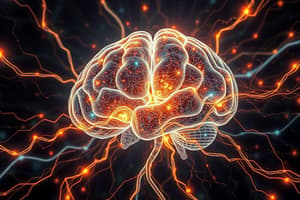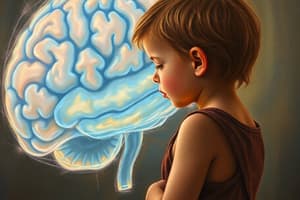Podcast
Questions and Answers
Which of the following is NOT a characteristic of experience-dependent plasticity?
Which of the following is NOT a characteristic of experience-dependent plasticity?
- Involved with learning and memory
- Involves persistent, long-lasting changes in the strength of synapses between neurons and within neural networks
- Can only occur in the central nervous system (correct)
- Requires synthesis of new proteins, growth of new synapses, and modifications of existing synapses
What is the main difference between recovery and compensation in the context of neural plasticity?
What is the main difference between recovery and compensation in the context of neural plasticity?
- Recovery is always better than compensation.
- Recovery is faster than compensation.
- Recovery involves restoring damaged tissue, while compensation involves using unaffected systems to perform tasks. (correct)
- Compensation is only possible in the peripheral nervous system.
Which of the following is a cellular method of change related to neural plasticity?
Which of the following is a cellular method of change related to neural plasticity?
- Changes in blood flow to the brain
- Long-term potentiation (LTP) (correct)
- Hormonal changes
- Increased production of neurotransmitters
How does long-term potentiation (LTP) affect the postsynaptic membrane?
How does long-term potentiation (LTP) affect the postsynaptic membrane?
What role does glutamate play in long-term potentiation (LTP)?
What role does glutamate play in long-term potentiation (LTP)?
Which of the following is an example of a maladaptive change related to neural plasticity?
Which of the following is an example of a maladaptive change related to neural plasticity?
What happens to synapses during long-term depression (LTD)?
What happens to synapses during long-term depression (LTD)?
What does the phrase "neural plasticity is not always a positive thing" mean in the context of the provided text?
What does the phrase "neural plasticity is not always a positive thing" mean in the context of the provided text?
What is the primary reason that axonal regeneration does not occur in the CNS?
What is the primary reason that axonal regeneration does not occur in the CNS?
Which of the following is NOT a principle of experience-dependent neuroplasticity?
Which of the following is NOT a principle of experience-dependent neuroplasticity?
Which brain structure is primarily responsible for receiving autonomic afferents?
Which brain structure is primarily responsible for receiving autonomic afferents?
What is the primary source of descending pathways from the CNS to target tissues for the somatic nervous system?
What is the primary source of descending pathways from the CNS to target tissues for the somatic nervous system?
Which of the following is NOT a characteristic of the autonomic nervous system?
Which of the following is NOT a characteristic of the autonomic nervous system?
What is the primary function of the sympathetic nervous system?
What is the primary function of the sympathetic nervous system?
How do the sympathetic and parasympathetic nervous systems interact?
How do the sympathetic and parasympathetic nervous systems interact?
Which of the following is an example of 'use it or lose it' principle of neuroplasticity?
Which of the following is an example of 'use it or lose it' principle of neuroplasticity?
What aspect of the autonomic nervous system differentiates it from the somatic nervous system?
What aspect of the autonomic nervous system differentiates it from the somatic nervous system?
How does the CNS respond to injury compared to the PNS?
How does the CNS respond to injury compared to the PNS?
Which of the following is NOT a characteristic of the sympathetic nervous system?
Which of the following is NOT a characteristic of the sympathetic nervous system?
The parasympathetic nervous system is primarily responsible for:
The parasympathetic nervous system is primarily responsible for:
Which of the following neurotransmitters is primarily released at postganglionic parasympathetic nerve terminals?
Which of the following neurotransmitters is primarily released at postganglionic parasympathetic nerve terminals?
What is the primary function of the autonomic afferent system?
What is the primary function of the autonomic afferent system?
Which type of receptor is responsible for sensing changes in blood pressure?
Which type of receptor is responsible for sensing changes in blood pressure?
What is the main role of the medulla in autonomic function?
What is the main role of the medulla in autonomic function?
What is the most severe form of Spina Bifida?
What is the most severe form of Spina Bifida?
What is the name of the developmental deformity of the hindbrain that can cause pressure on the brainstem?
What is the name of the developmental deformity of the hindbrain that can cause pressure on the brainstem?
During which stage of nervous system development does the neural tube form?
During which stage of nervous system development does the neural tube form?
What is the primary function of the radial glia during nervous system development?
What is the primary function of the radial glia during nervous system development?
Which embryonic layer gives rise to the nervous system?
Which embryonic layer gives rise to the nervous system?
What is the term for the group of muscles innervated by a single spinal nerve?
What is the term for the group of muscles innervated by a single spinal nerve?
Which of the following brain regions develops from the prosencephalon?
Which of the following brain regions develops from the prosencephalon?
What is a common characteristic of autism spectrum disorders?
What is a common characteristic of autism spectrum disorders?
Which of the following clinical conditions is NOT associated with autonomic nervous system dysfunction?
Which of the following clinical conditions is NOT associated with autonomic nervous system dysfunction?
What is the primary symptom associated with Horner's Syndrome?
What is the primary symptom associated with Horner's Syndrome?
What is the primary role of brain-derived neurotrophic factor (BDNF) in neural plasticity?
What is the primary role of brain-derived neurotrophic factor (BDNF) in neural plasticity?
How does experience-expectant plasticity relate to the development of ocular dominance columns?
How does experience-expectant plasticity relate to the development of ocular dominance columns?
What is the primary implication of the 'critical period' concept in relation to language acquisition?
What is the primary implication of the 'critical period' concept in relation to language acquisition?
Which of the following is NOT a characteristic of normal (adaptive) cortical map plasticity?
Which of the following is NOT a characteristic of normal (adaptive) cortical map plasticity?
What is the primary mechanism observed in animal studies for recovery of hand function following stroke damage to the primary motor cortex?
What is the primary mechanism observed in animal studies for recovery of hand function following stroke damage to the primary motor cortex?
What is the main principle behind Constraint-Induced Movement Therapy (CIMT) for stroke recovery?
What is the main principle behind Constraint-Induced Movement Therapy (CIMT) for stroke recovery?
What is the primary cellular mechanism involved in habituation, a decrease in response to a repetitive, benign stimulus?
What is the primary cellular mechanism involved in habituation, a decrease in response to a repetitive, benign stimulus?
What is the primary distinction between collateral sprouting and regenerative sprouting in the PNS response to axon damage?
What is the primary distinction between collateral sprouting and regenerative sprouting in the PNS response to axon damage?
What is Wallerian degeneration?
What is Wallerian degeneration?
Which of the following is NOT a factor that influences recovery from CNS damage?
Which of the following is NOT a factor that influences recovery from CNS damage?
Which of the following statements about the effects of exercise on brain plasticity is TRUE?
Which of the following statements about the effects of exercise on brain plasticity is TRUE?
How does the concept of plasticity relate to the resolution of cortical maps?
How does the concept of plasticity relate to the resolution of cortical maps?
Which of the following is a key difference between how the CNS and PNS respond to axon damage?
Which of the following is a key difference between how the CNS and PNS respond to axon damage?
Which of the following is an example of a clinical implication of habituation?
Which of the following is an example of a clinical implication of habituation?
Which of the following are mechanisms associated with motor recovery after stroke damage to the primary motor cortex? (Select all that apply)
Which of the following are mechanisms associated with motor recovery after stroke damage to the primary motor cortex? (Select all that apply)
Flashcards
Neural Plasticity
Neural Plasticity
The ability of the nervous system to change functions, chemical profiles, or structures based on experience.
Recovery vs. Compensation
Recovery vs. Compensation
Recovery restores damaged brain functions; compensation involves unaffected systems taking over for the damaged ones.
Experience-Dependent Plasticity
Experience-Dependent Plasticity
Changes in cellular structure related to experiences; involves synapse strength and networks.
Long-Term Potentiation (LTP)
Long-Term Potentiation (LTP)
Signup and view all the flashcards
Long-Term Depression (LTD)
Long-Term Depression (LTD)
Signup and view all the flashcards
Synaptic Changes
Synaptic Changes
Signup and view all the flashcards
Glutamate in LTP
Glutamate in LTP
Signup and view all the flashcards
Maladaptive Plasticity
Maladaptive Plasticity
Signup and view all the flashcards
CNS Response
CNS Response
Signup and view all the flashcards
Glial Scars
Glial Scars
Signup and view all the flashcards
Plasticity
Plasticity
Signup and view all the flashcards
Critical Period
Critical Period
Signup and view all the flashcards
Experience-Dependent Neuroplasticity Principle 1
Experience-Dependent Neuroplasticity Principle 1
Signup and view all the flashcards
Autonomic Nervous System (ANS)
Autonomic Nervous System (ANS)
Signup and view all the flashcards
Sympathetic vs. Parasympathetic
Sympathetic vs. Parasympathetic
Signup and view all the flashcards
Somatic vs. Autonomic Nervous System
Somatic vs. Autonomic Nervous System
Signup and view all the flashcards
Dual Innervation
Dual Innervation
Signup and view all the flashcards
Efferent Pathways
Efferent Pathways
Signup and view all the flashcards
PSNS
PSNS
Signup and view all the flashcards
SNS
SNS
Signup and view all the flashcards
ANS Efferent System
ANS Efferent System
Signup and view all the flashcards
Sympathetic Division
Sympathetic Division
Signup and view all the flashcards
Parasympathetic Division
Parasympathetic Division
Signup and view all the flashcards
Autonomic Afferents
Autonomic Afferents
Signup and view all the flashcards
Visceral Receptors
Visceral Receptors
Signup and view all the flashcards
Baroreceptor Reflex
Baroreceptor Reflex
Signup and view all the flashcards
Micturition Reflex
Micturition Reflex
Signup and view all the flashcards
Anencephaly
Anencephaly
Signup and view all the flashcards
Spina Bifida
Spina Bifida
Signup and view all the flashcards
Cerebral Palsy
Cerebral Palsy
Signup and view all the flashcards
Autism Spectrum Disorders
Autism Spectrum Disorders
Signup and view all the flashcards
Diencephalon
Diencephalon
Signup and view all the flashcards
Neural Tube Formation Defects
Neural Tube Formation Defects
Signup and view all the flashcards
LTP
LTP
Signup and view all the flashcards
LTD
LTD
Signup and view all the flashcards
BDNF
BDNF
Signup and view all the flashcards
Experience-Expectant Plasticity
Experience-Expectant Plasticity
Signup and view all the flashcards
Ocular Dominance Columns
Ocular Dominance Columns
Signup and view all the flashcards
Congenital Cataract
Congenital Cataract
Signup and view all the flashcards
Strabismus
Strabismus
Signup and view all the flashcards
Reorganization of Cortical Maps
Reorganization of Cortical Maps
Signup and view all the flashcards
Synaptogenesis
Synaptogenesis
Signup and view all the flashcards
Constraint-Induced Movement Therapy (CIMT)
Constraint-Induced Movement Therapy (CIMT)
Signup and view all the flashcards
Habituation
Habituation
Signup and view all the flashcards
Wallerian Degeneration
Wallerian Degeneration
Signup and view all the flashcards
PNS Response to Injury
PNS Response to Injury
Signup and view all the flashcards
Study Notes
Neural Plasticity
- Nervous system's ability to change functions, chemical profiles, or structures, shaped by experience.
- Cannot change without experience.
- Differences exist between Central Nervous System (CNS) and Peripheral Nervous System (PNS) in plasticity methods.
- Reorganization of structure, function, and connections in response to intrinsic and extrinsic stimuli.
- Can be observed as changes in individual neurons or entire systems.
- Maladaptive recovery is possible, not always positive.
Recovery vs. Compensation
- Recovery: Restoration of damaged brain functions and neural tissues.
- Compensation: Unaffected systems taking over damaged ones (undesirable).
Experience-Dependent Plasticity
- Changes in cellular structure (synapses, receptor density) are involved.
- Leads to alterations in neural networks, behavior, and task performance.
- Involves long-lasting changes in synaptic strength within neural networks.
- Crucial for learning and memory; requires new protein synthesis, synapse growth, and existing synapse modifications.
Long-Term Potentiation (LTP)
- Repeated use of a synapse strengthens the connection.
- Conversion of “silent” synapses (lacking certain receptors) to active ones over time.
- Changes in postsynaptic membrane shape (increased surface area).
- Generation of new dendritic spines and synapses.
- Involves glutamate receptors (NMDA, AMPA).
- Glutamate binding to NMDA triggers Ca2+ influx.
- Ca2+ influx activates AMPA receptors, making the postsynaptic membrane more likely to depolarize upon glutamate release.
Long-Term Depression (LTD)
- Lack of synapse use leads to removal of AMPA receptors.
- Can result in loss of dendritic spines.
- Postsynaptic membrane is less likely to depolarize when glutamate is released.
Brain-Derived Neurotrophic Factor (BDNF)
- Neurotrophic protein influencing neural plasticity.
- Supports existing neuron survival, new neuron and synapse growth/differentiation.
- Supports axonal and dendritic sprouting.
- Marker of plasticity, crucial for recovery processes.
Experience-Expectant Plasticity (Developmental Neuronal Plasticity)
- Changes in CNS organization during development.
- Example: Ocular dominance columns critical for binocular vision and depth perception.
- Early visual development can be disrupted by conditions like congenital cataracts and strabismus.
Critical Periods
- Limited time frames for optimal development of specific functions.
- Vision's Critical Period: Visual cortex neuronal wiring is malleable during a critical time.
- Language's Critical Period: Native fluency is more likely during early childhood language exposure.
- Hearing's Critical Period: Cochlear implants are most effective when implanted early.
Normal (Adaptive) Cortical Map Plasticity
- Innervation density affects cortical map resolution (ex: Motor and somatosensory homunculi).
- Homunculus maps vary in size, but the topographical order generally remains stable.
Cortical Map Plasticity in Response to Injury
- High innervation density in digit-related areas.
- Animal studies show cortical redistribution following digit removal.
Plasticity and CNS Damage Recovery
- Recovery depends on age, injury extent/location, pathology, and rehabilitation implementation.
- Reorganization is generally within the affected system.
- Examples include motor recovery after stroke.
Recovery from Stroke
- Animal studies show increased synaptogenesis and dendritic remodeling after stroke.
- Training can upregulate BDNF, linked to recovery.
- Hand function recovery may involve activity shifts to alternative cortical areas (ipsilateral hemisphere, bilateral cortices).
Exercise and Plasticity
- Exercise increases BDNF, mRNA, and proteins in brain regions (cerebral cortex, cerebellum, spinal cord).
Intervention Strategies
- Constraint-induced movement therapy (CIMT) forces use of affected extremities.
- High-intensity treadmill training
Habituation
- Decrease in response to repeated stimuli.
- Potential cellular mechanisms: reduced excitatory neurotransmitter release, decreased intracellular Ca2+ release.
- Prolonged repetition leads to more permanent structural changes, potentially decreasing synapse numbers.
Cellular Recovery After Injury
- CNS: Limited axonal regeneration due to lack of nerve growth factor (NGF) and glial scar formation.
- PNS: More robust regeneration due to NGF within Schwann cells and greater collateral/regenerative sprouting potential.
Principles to Enhance Experience-Dependent Neuroplasticity
- Use it or lose it: Maintain relevant activity levels.
- Use it and improve it: Optimize activity quality for desired changes.
- Specificity: Focused tasks promote targeted improvements.
- Repetition: Repeated engagement yields stronger results.
- Intensity: Optimal intensity promotes optimal response.
- Time: Consistent engagement over a period leads to greater change.
Autonomic Nervous System
- Maintains homeostasis through regulation of internal organs.
- Influencing smooth muscle, cardiac muscle, secretory glands, and visceral targets.
- Two main divisions: sympathetic ("fight or flight" ) & parasympathetic ("rest and digest").
Similarities/Differences, Somatic & Autonomic
- Similarities: Both have afferent and efferent fibers.
- Differences:
- Autonomic regulation typically nonconscious, hormonal.
- Internal organs function independent of CNS input.
- Somatic efferent: one neuron; autonomic: two neurons with a synapse outside CNS.
General Physiological Differences, SNS/PSNS
- SNS: Increases energy use, "fight or flight".
- PSNS: Most active at rest, conserving energy for digestion/restoration.
Autonomic Afferents
- Originate from visceral receptors and blood vessels.
- Enter spinal cord or brainstem via dorsal roots/cranial nerves.
- Types of receptors: mechanoreceptors, chemoreceptors, nociceptors, thermoreceptors.
Referred Pain
- Visceral and somatic afferents converge; visceral pain may seem to emanate from a different somatic region.
Control of Autonomic Function
- Medulla, pons, hypothalamus, thalamus, and limbic systems regulate.
Functions, SNS/PSNS
- SNS: Increased HR, BP, blood glucose, respiration, digestion inhibition; vital for stressful situations.
- PSNS: Increased digestion, B&B function, energy conservation; important for rest.
ANS Dysfunction
- Peripheral nerve injuries, spinal cord lesions, brainstem/cerebral involvement can cause ANS issues.
- Disorders: hypertension, postural hypotension, syncope, etc.
Horner's Syndrome
- Caused by loss of sympathetic innervation.
- Signs: miosis (pupil constriction), ptosis (drooping eyelid), anhidrosis (lack of sweat).
Autonomic Dysreflexia
- Life-threatening condition (spinal cord injury above T6).
- Characterized by sudden high BP, headache, and sweating.
- Treated by promptly sitting the affected person upright.
Development of Nervous System
- Stages: pre-embryonic, embryonic, fetal
- Neurulation forms neural tube (CNS).
- Cell proliferation, migration, differentiation, and synaptogenesis occur.
- Myelination begins during fetal development.
- Susceptibility to malformations between week 2 and 20 of gestation.
Neural Tube Formation Defects
- Anencephaly: Absence of brain structures, typically fatal.
- Spina bifida (occulta, cystica, myelomeningocele): Varying degrees of spinal cord exposure.
- Arnold-Chiari malformation: Hindbrain herniation.
- Tethered spinal cord: Spinal cord attachment issues.
Cerebral Palsy
- Nonprogressive movement and postural disorder.
- Caused by brain damage.
- Various types: spastic, dyskinetic, ataxic, hypotonic, mixed.
Autism Spectrum Disorders
- Range of social and communication deficits, repetitive behaviors, limited interests.
- Brain differences observed (reduced inter-cerebral communication, larger amygdala).
Clinical Implications of Development
- Crucial role of prenatal care (folate for neural tube defects).
- Critical periods in the developing nervous system.
- Variations between developing and matured nervous systems.
Studying That Suits You
Use AI to generate personalized quizzes and flashcards to suit your learning preferences.



